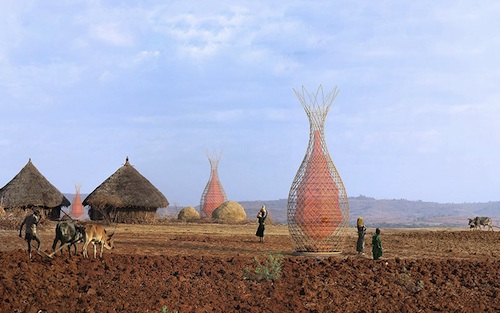The state of running water and sanitation in the world isn’t great, and while big names like Bill Gates and Matt Damon have donated time and money to the efforts, they can still be costly. The newest version of the Gates toilets cost about $2,000 to install and more to maintain, and with many water projects in Africa and other parts of the developing world, the base idea requires energy (possibly at a premium) and access to spare parts if something breaks (could be a logistical challenge). For many, the problem seems insurmountable.
There’s a new idea out there, though: it has wrinkles and context that needs to be worked out, as does everything, but it’s called “Warka Water” and it can be installed for about $500 in a village and provide 25 gallons of clean drinking water per day. It literally pulls water out of the air:
The rigid outer housing of each tower is comprised of lightweight and elastic juncus stalks, woven in a pattern that offers stability in the face of strong wind gusts while still allowing air to flow through. A mesh net made of nylon or polypropylene, which calls to mind a large Chinese lantern, hangs inside, collecting droplets of dew that form along the surface. As cold air condenses, the droplets roll down into a container at the bottom of the tower. The water in the container then passes through a tube that functions as a faucet, carrying the water to those waiting on the ground.
So basically, condensation is helping to create 25 gallons of water per day. I don’t remember fifth and sixth grade (at all) science very well, but the driving force of condensation is apparently the difference in temperature at nightfall and daybreak. In desert areas, that can be as much as 50 degrees, which can yield that much water. The parts of the tower are biodegradable and you can build it, without any mechanical tools, in about a week or so. All this sounds very good.
Now let’s go back to the number: 25 gallons a day. That’s certainly better than “zero gallons” per day, but the recommended amount of water for a person to drink every day (which varies greatly depending on who you ask) is around 3.7 liters a day for men and 2.7 liters a day for women. 3.7 liters is about .97 gallons, so round that to 1. If this was put in a small village — 50 men, 50 women for ease of math — it would still create too little for even the men. Now, we’re basing this off first-world water consumption estimates, but still, even if we downgrade, it’s not really enough for even a village of 100. That’s a potential concern, given that it is a $500 installation and leaves a 30-foot tower behind.
World water usage and sanitation issues are definitely one of the impending challenges of future generations. Warka Water is definitely a good start, and maybe with more resources behind it, it could be scalable to the point of being a great start, but the problem is pretty big right now and might require an altogether-new invention or logistical supply chain to be rectified.
Here’s some more about Warka Water, including some other-angle photos.
